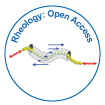Review Article
Challenging Conditions to Observe Shear Banding In Highly Entangled Polybutadiene Solutions
Shi-Qing Wang*Morton Institute of Polymer Science and Engineering, University of Akron, Akron, Ohio 44325, USA
- *Corresponding Author:
- Shi-Qing Wang
Morton Institute of Polymer Science and Engineering
University of Akron, Akron, Ohio 44325, USA
Tel: 330-972-7108
E-mail: swang@uakron.edu
Received date: December 07, 2016; Accepted date: March 01, 2017; Published date: March 08, 2017
Citation: Wang S (2017) Challenging Conditions to Observe Shear Banding In Highly Entangled Polybutadiene Solutions. Rheol: open access 1:104
Copyright: © 2017 Wang S. This is an open-access article distributed under the terms of the Creative Commons Attribution License, which permits unrestricted use, distribution, and reproduction in any medium, provided the original author and source are credited.
Abstract
There is general agreement that the observation of shear banding in well entangled polymer solutions and melts has strong implications for existing models of chain entanglement during large deformation. Understandably, observations of this phenomenon in numerous past measurements have been viewed by some as controversial because of the challenge that these observations raise for the current paradigm of nonlinear polymer rheology. We welcome independent measurements aimed at verifying or refuting the existing conclusions based on carefully prepared, well-characterized and strongly entangled polymer solutions. It is clear that measurements were based on solutions that were either only marginally entangled or polydisperse, which understandably did not exhibit shear banding under the weak shearing conditions that they chose stated “we agree that the sample MW is different from that specified by the supplier and has the Z=22 entanglement number”. But rather than making additional measurements on well entangled relatively monodisperse PB solutions following previous protocols, they continue to speculate that their former measurements were sufficient to demonstrate that shear banding does not exist in highly entangled polymer solutions under all conditions. We find position to be unconvincing and discuss in detail why we reject their conclusions, including a description of why the previous solutions researchers had the correct characterization.

 Spanish
Spanish  Chinese
Chinese  Russian
Russian  German
German  French
French  Japanese
Japanese  Portuguese
Portuguese  Hindi
Hindi